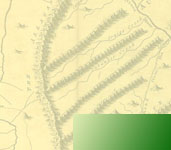Teacher Note's
Links to the lesson plans are through the module title. These are also available on the student pages.
Examining Culture through the Lens of a Will (lesson plan)
Grades/Level: Middle School (7-9), High School (9-12)
Subjects: Social Studies, Language Arts
Time Requirement: 90 minutes Homework: Short expository post-activity writing.
Overview: Very few documents survive that were written from the perspective of enslaved people in Virginia. We learn about their lives through letters, legal documents, plantation accounts, and newspaper stories and advertisements written by white landowners, and through archaeology. In order to understand the history of one group of slaves who lived in central Virginia in the 1700s, we will start by reading the will of a wealthy landowner who considered them, by the laws of the day, to be his property. More broadly, by reading this will we can explore what the will of a wealthy landowner tells us about the culture of the time.
Examining land ownership at Indian Camp (lesson plan)
Grades/Level: Middle School (7-9), High School (9-12)
Subjects: Social Studies, Language Arts
Time Requirement: 90 minutes Homework: Short expository post-activity writing.
Overview: Students will engage with changing land ownership at the Indian Camp plantation from 1710 through 1770, revieving an interactive map, and related primary documents. The broad questions are: How did rivers and roads affect development? What was the effect of land fragmentation and family ownership on the building of community, for both the land owners and their enslaved workers?
Bones and Seeds - Examining the faunal and botanical remains at Wingo's (lesson plan) 2 modules
Download Lesson Plan (PDF)
Grades/Level: Middle School (7-9), High School (9-12)
Subjects: Science, Social Studies, Language Arts, Math, Statistics
Time Requirement: 90 minutes homework: Short expository post-activity writing.
Overview: The study of animal bones provides valuable information about diet and the production and collection of food. The data provided for this exercise were collected through careful excavation and presented in reports from specialists in faunal remains (zooarchaeologists) and botanical remains (paleoethnobotanists).
Students are asked to complete two exercises:



